1-3-24
Hlynur Pálmason’s Godland: A Saga of Fire and Ice
By Diane Sippl
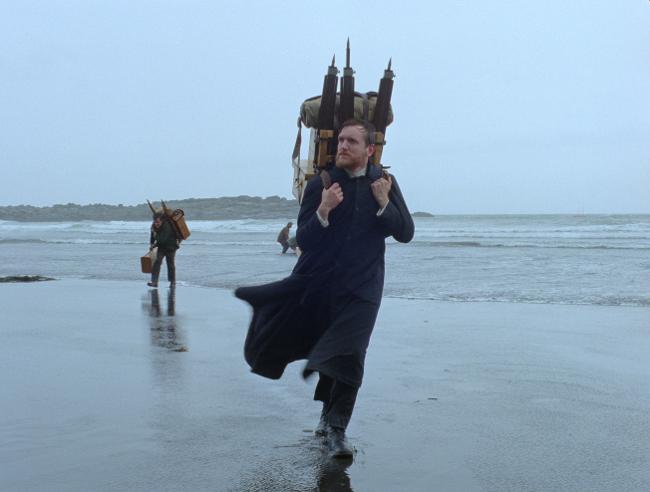
Early on it’s hard to ignore that Godland is taking us on a new kind of journey, one that seems strange not just because the elements—land, water, wind, and fire—emerge with the alien luster of every mix in-between: glaciers, tundra, smoke and lava. Beyond these unfamiliar sights and sensations, the film’s narrative itself unrolls in uncustomary ways.
The story arrives not simply by plot and dialogue; it both doubles back and lurches forward on the wings of saga and song. Tales of old are told or sung spontaneously as if happening in-the-moment. Maybe they are new, or even foretelling, venting deep emotions under portentous skies. Yet add to this the fact that the look of the film is not cinematic but photographic, starting with the aspect ratio of the old academy format and the black gate surrounding the images that softens them at the edges. Every element of Godland follows from these two primary choices for narration and image, because they carry the themes: faith, effort, and defeat, but experienced very differently depending on the character.
Two men, two cultures, two temperaments: a scrappy, soulful, tower of knowledge, a keeper of nature’s ways, and of how to bow and bend to them, is assigned as an aid to a city-slicker cleric, more pretentious than pious, a prickly priest who does not do well for his fold. In broader strokes, we have the clash between earthly reality and heavenly ideals in a contested space that outlasts both. Around the 1890s, a Danish priest, Lucas, embarks on a mission to build a Lutheran church in Iceland, yet his increasing dependence on a local guide, Ragnar, leads not to gratitude for his host’s wisdom and labor but to infuriation, hostility, and self-destruction. Astounded by the priest’s single-minded arrogance and increasing stubbornness, Ragnar begins to express attitudes of his own. However, whereas Lucas’ bull-headed need to take command leads to a drowned man, Ragnar’s sheer compassion saves Lucas’ life. That last favor is returned with a vengeance, one enacted by another player: such is the irony of colonization, a lose-lose proposition. Yet despite the tragic tale it presents, owing to its aesthetic dimensions, Godland creates a highly lyrical sense of awe.
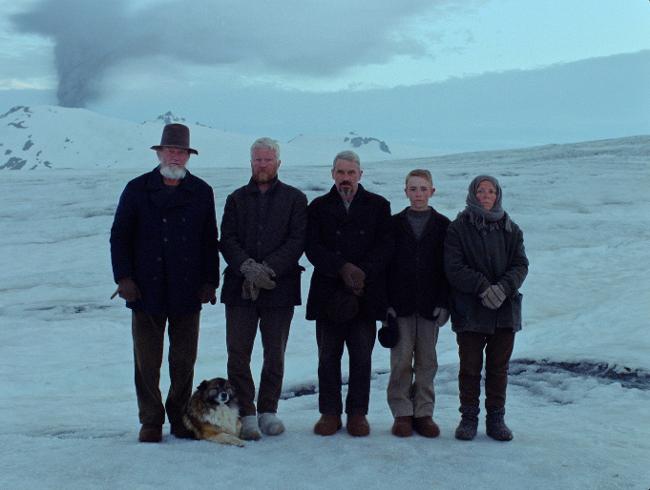
“The New Land” Is Old—and Living
The traditional Icelandic saga is prevalent not only in the outer shell of the film, but also within it, given the eerie, surreal ways that vocal storytelling and singing presage the events. In an early scene around the campfire with the Icelandic members of the priest’s caravan, Ragnar tells a tale of eels mating and moaning in the mud, one that ultimately warns of sexual invaders of a man’s home and family. The cross-cutting is to Lucas and his handsome translator on a personal trek to a monumental waterfall, the two men’s arms flung open to the heavens as they rejoice, bare-chested, in God’s creation, the mountain waters gushing to a pond below.
Midway through the film, we get to know Carl, a farmer from Denmark who has settled in a valley with his two comely daughters. The younger and pluckier one, Ida, sings a ballad filling in the personal names of her own family members as the gory song forecasts human slaughter and comeuppance. Throughout the film, Ragnar doles out commentary, crooning like a cowboy on the prairie, about the atmosphere and the priest’s progress or lack thereof. The instinctive Ragnar gives free reign to his own impressions of the people in his company and the situation at-hand. It’s highly doubtful that the Danish priest understands a word of it: Ragnar speaks in his native tongue.
Each of these styles for articulating the events of the film propels our subconscious attention to a uniquely Icelandic mode of expression that draws from forms of language handed down and, to this day, inhabiting a literature at least a thousand years old. Godland itself was, in fact, inspired not by a found box of photographs from the 19th century, as the opening intertitles tell us (a ruse typical of this wryly playful writer-director), but by a poem called Volaða Land by Matthías Jochumsson evoking a dreadful winter experienced by the poet, reportedly a friend of the filmmaker’s great, great grandfather.
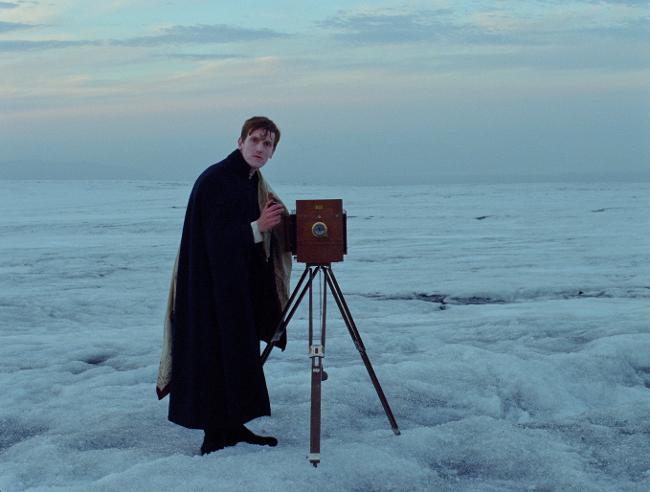
“The Old World” Is New—and Dying
The use of photography in the film, an homage to the marvels of the continent’s new technology, reveals a strategy that is at least twofold as far as the priest is concerned. Ironically, the exhilarating deployment of the camera lens filters Lucas’ perspective on the endlessly surprising land he intends to survey but can hardly begin to discover: glaciers melting into rushing rivers, waterfalls roaring from rocky cliffs, volcanos spewing lava streams of fire and ash, pastel skies in the midnight sun.
On the other hand, that same camera lens, one that he time and again uses to focus on the figures of humans, distances Lucas from the very people he has set out to serve. His stationary camera requires his subjects to pose like possums in lifeless positions with sober expressions, not blinking, not twitching, for the requisite lengthy spells of the early photographic method. What’s more, his controlling camera is the only means by which he draws close to these people, fixing them within his self-designed frame when he should be inviting them into the world of God, or at least bowing with open and friendly good will (humility, kindness, and generosity) to earn their trust and respect.
The priest’s instrument for perceiving, recording, and ultimately sharing “life” in Iceland shutters him from the actual contact he would need to experience that life. Hiding behind his viewfinder, he takes still photographs rather than offering a living dialogue. (He gave up on the new language during his sea voyage to arrive there, when he was taught “too many Icelandic words for rain.”) Carl, the father of the proverbial “farmer’s daughters,” invites Lucas to sit as his table for family dinner and quietly mocks the priest (who looks ashen from exhaustion and is due momentarily for a nosebleed). Seeing the toll that overland expedition has taken on Lucas, Carl asks him,
“Why the long journey when you could have just sailed here?”
“I wanted to travel, to see the land and get to know it, photograph it and its people,” says Lucas.
Anna, Carl’s marriageable daughter and the priest’s heart-throb, smiles and asks. “What people? Were there many on your way?”
“I don’t know,” replies Lucas.
“Who did you meet?” inquires Carl.
“I don’t remember,” sighs Lucas, as the camera focuses on Ragnar across the table.
“Of course. It’ll come back to you. So what do you think about this unforgiving land?” asks Carl.
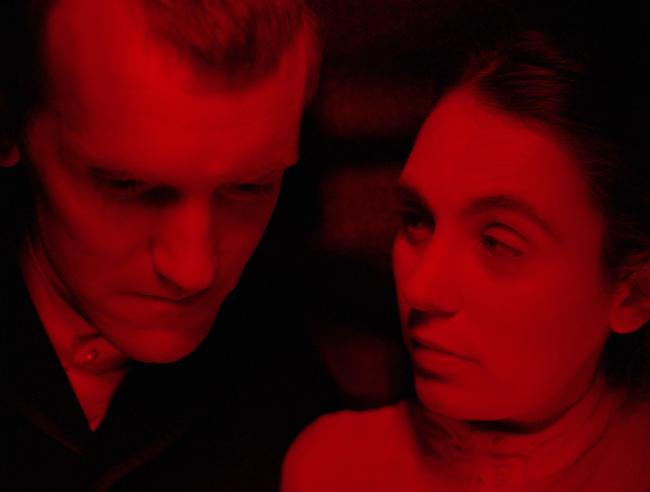
In the striking prelude to Lucas’ departure, at his initial meeting in Denmark with his religious superior in his plush office at his table of bounty, this functional novice was warned about preaching abroad: “the volcano emits a stench, a smell so foul, it’s as if the Earth has shat its pants. The smell can be so overwhelming that people lose their minds. That’s easy to do.” And, as predicted, for all his theological education and prestigious training, Lucas’ is beside himself when facing any interaction with the very “flock” he has come to inspire and lead with the word of God. But he will have captured and preserved documentation of what is “new” for Denmark’s “old world” archives upon his return.
This missionary’s photography fits the classic pattern in colonization—traversing the land to explore its resources, both inherent and potential, and if possible, recording them with pictorial precision all the while abstaining from any participatory curiosity (which might jeopardize the mission, after all.) And through the camera, as from the pulpit, Lucas employs the tools of power—except that by the time we get to the first full Sunday service, he’s already so literally weak-kneed with fear, guilt, and paranoia that he lands in the mud outside the church door, and it oozes from his black frock and white accordion-pleated collar. The intimidations of the land and the brazen, cowardly, colossal missteps it has triggered from his out-of-bounds self are too much for Lucas. Feeling himself a holy terror in his own skin, he has already experienced a total loss of confidence, praying alone in his tent one night, “Lord, you need not be here…”
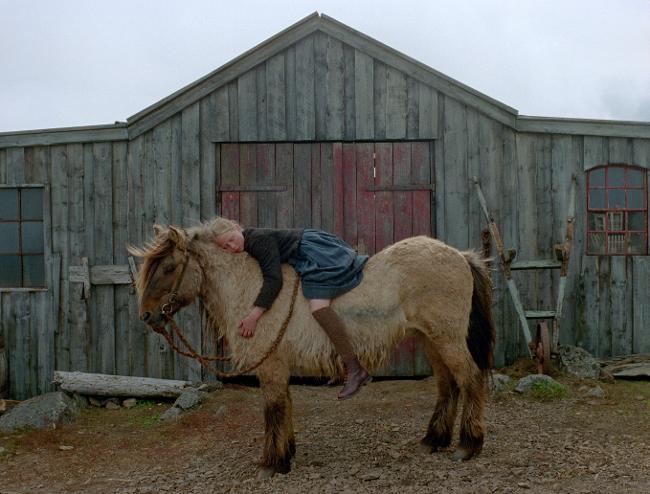
The Mix Survives
Those who are already there, who live there and work the land, a mix of Icelanders and Danes in this valley, who are alive and well without the priest’s presumed spiritual guidance, elicit images from the filmmaker that are painterly counterpoints to the priest’s still landscapes and portraits; the cinematic shots are utterly juxtaposed with Lucas’ photos, expert that he is. Carl’s daughter Ida has fun tormenting Lucas when he strives to photograph her on her horse, which was surely her idea. Ida stands upright on her horse’s bare back (which we see inverted in Lucas’ viewfinder, for added irony). “Please sit down,” he begs her, and she then strikes three cheeky poses—straddling her horse, facing his butt; lying down prone on her back upon her horse’s back, her feet crossed, arms overhead; and finally sitting with both legs to one side, but with her back to the camera. Showing off her strong bond with her horse and the natural world, her poise with adults, her comfortable sense of humor, she has a picnic mocking the priest.
A more spontaneous and yet masterfully idyllic scene lets the cinematographer critique the photographer’s propped-up camera when we get a 360-degree panning shot of the real picnic the settlers enjoy: Ragnar plays his accordion, couples frolic on the grass, eating and drinking and chatting, a mother breastfeeds her baby, children play with balls, with dogs, men smoke pipes sitting on the church scaffold. It’s a wedding, a sharing of bonds, a celebration of life, life-in-motion, ephemeral moments, fleeing at the end of the day, but perhaps never forgotten.
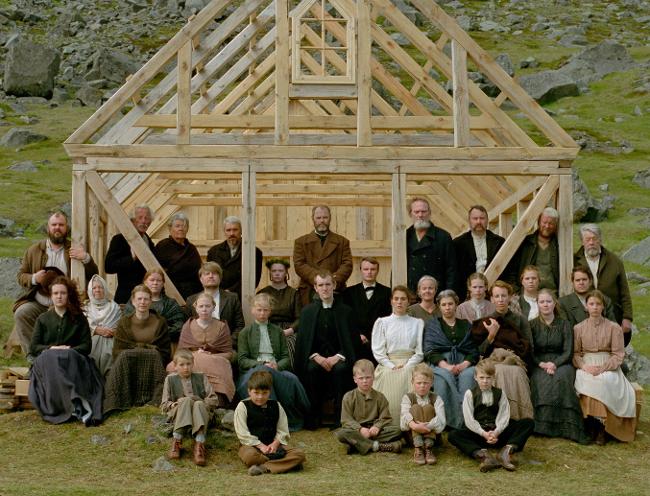
What feels like natural sound in much of the film—the howling wind, the creaking ice—or sometimes a mystical, surreal sound bank, especially accompanying spoken tales, is really the braying of an improvisational saxophone, music composed by Alex Zhang Hungtai. Both Godland’s cinematographer, award-winning Maria von Hausswolff, and its editor, Julius Krebs Damsbo, continue their work in this film from the director’s recent A White, White Day, a striking character study featuring both the formidable Ingvar Sigurdsson and the up-and-coming Ída Mekkín Hlynsdóttir, who impress once again as Ragnar and Ida in Godland. Ida, Pálmason’s daughter, aspires to become a horse trainer and a part-time actress. As for writer-director Hlynur Pálmason, born in Iceland and becoming a visual artist, he then studied in Denmark and became a filmmaker as well. He continues to live and work in both countries; Godland, Iceland’s submission for the 96th Academy Awards, is shortlisted in the category of Best International Feature Film.
Godland
Producers: Katrin Pors, Anton Máni Svansson, Eva Jakobsen, Mikkel Jersin; Director: Hlynur Pálmason; Screenplay: Hlynur Pálmason; Cinematography: Maria von Hausswolff; Editing: Julius Krebs Damsbo; Music: Alex Zhang Hungtai; Sound Design: Björn Viktorsson & Kristian Selin Eidnes Andersen; Production Design: Frosti Friðriksson; Costumes: Nina Grønlund.
Cast: Elliott Crosset Hove, Ingvar Sigurðsson, Vic Carmen Sonne, Jacob Hauberg Lohmann, Ída Mekkín Hlynsdóttir, Waage Sandø, Hilmar Guðjónsson.
143 min., Color. In Danish and Icelandic with English subtitles.